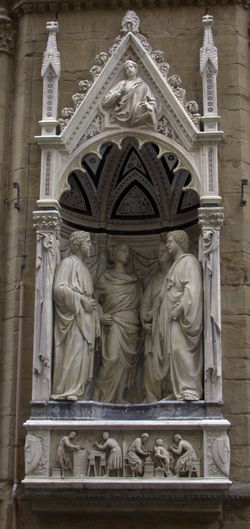Nanni di Banco

This article needs additional citations for verification. (December 2015) |
Nanni di Banco | |
|---|---|
 | |
| Born | c. 1385 |
| Died | 1421 |
| Nationality | Italian |
| Known for | Sculptor |
| Movement | Italian Renaissance |

Nanni d'Antonio di Banco (c. 1384 – 1421) was an Italian Renaissance sculptor from Florence. He was a contemporary of Donatello – both are first recorded as sculptors in the accounts of the Florence Duomo in 1406, presumably as young masters.[1]
Early life
[edit]He was born in Florence, Italy, the son of Antonio di Banco, a stonecutter, sculptor, and supplier employed at the building works of Florence Cathedral, Santa Maria del Fiore.[2] The date of his birth is uncertain, and has been placed as early as 1375 and as late as 1390. He was most likely born in the mid-1370s.[3] Di Banco worked with Donatello, though Donatello was not, as Vasari thought, Nanni's instructor. As to Nanni's training, this probably took place within the circle of Florentine masons, stonecutters, and sculptors at work on the Cathedral, and in particular in the context of the work known to have started in 1391 on the decoration of the north door, later called the Porta della Mandorla. Giovanni d'Ambrogio, whose work, according to Kreytenberg, "provided a decisive impetus for the emergence of Renaissance sculpture", has been described by Manfred Wundram as the "true mentor of Donatello, and even more so of Nanni di Banco".[4] In February of 1405 Nanni was admitted into the guild known as the "Arte dei Maestri di Pietra e Legname", membership of which gave him status as a qualified sculptor and allowed him to work as such at the cathedral. Nanni and his father were commissioned to carve the statue of the prophet Isaiah for the cathedral.
Career
[edit]Nanni was the master of his and his father’s workshop whence Donatello was recruited to sculpt the David. Nanni was selected to carve a sculpture of the evangelist Luke which took him 5 years to complete. He is mostly known for his work in transitioning from gothic to renaissance art.
Colleagues
[edit]A contemporary of Donatello and Lorenzo Ghiberti, Nanni di Banco was a sculptor in fifteenth-century Florence.[5] He is well known for his sculpture group Four Crowned Martyrs (Quattro Santi Coronati) (1412–15) which was commissioned by the stone carvers and wood workers guild for the Church of Orsanmichele.[6] The significance of this work is not only the striking naturalism and individuality of the figures, but also the complexity of construction of a sculpture group.
Works
[edit]Nanni di Banco made a name for himself in the transition from International Gothic art to Renaissance art, creating a path for the Early Renaissance in Florence. Many of his works are displayed inside the Cathedral and in the Church and Museum of Orsanmichele in Florence. His first major work was a statue of the prophet Isaiah in 1408 for the Cathedral, which employed his father.
The Quattro Coronati was created in 1416. Di Banco decided to depict a dialogue between four saints, thus the title. The sculpture not only illustrates dialogue but also demonstrates the extent to which human behavior can be portrayed in stone. The influence of ancient Roman sculpture is easily detected in the execution of the four sculptures. Many of the faces and togas look similar to those depicted in sculptures from the time of the Roman Republic. Artists were required to create a sculpture for the outside of church of St. Michele. Di Banco's colleague, Donatello, is credited with sculpting one of the saints. Di Banco portrays a dialogue in which only one of the four men is speaking and the rest are listening, not looking directly at the subject but still engaging in conversation.
Di Banco carved a marble statue of the Christian evangelist, St. Luke (San Luca) as part of a series with Donatello's St. John, Bernardo Ciuffagni's St. Matthew and Niccolò di Pietro Lamberti's St. Mark, in which Di Banco exploits a new approach to expressing human feeling with themes of humanism, the influence of this philosophical movement being expressed in the outline and in the human face through shadowing and posture. One of the earliest examples of the development of contrapposto in the Quattrocento is Nanni di Banco's Saint Philip, a standing, draped figure, located on the north side of Orsanmichele.[7]
Giorgio Vasari includes a biography of Nanni di Banco in his Lives of the Most Excellent Painters, Sculptors, and Architects.
Main works
[edit]- Main relief of the Assumption, Porta di Mandorla, Florence Cathedral (1414–21)
- St. Luke (1408-1415), Florence Cathedral
- Quattro Santi Coronati (Four Saints) (1408–15) - Orsanmichele, Florence
References
[edit]- ^ Seymour, 30
- ^ Rubin, Patricia Lee (2007). Images and Identity in Fifteenth-century Florence. Yale University Press. p. 63. ISBN 978-0-300-12342-5.
- ^ Pope-Hennessy, Sir John Wyndham (1996). An Introduction to Italian Sculpture. Phaidon Press. p. 271. ISBN 978-0-7148-3014-8.
The date of Nanni di Banco's birth is uncertain, and has been set as early as 1374 and as late as 1390. As has been argued by Wundram and other scholars, the most likely birth date is in the mid-1370s.
- ^ Kreytenberg, G. (2012). Hourihane, Colum (ed.). The Grove Encyclopedia of Medieval Art and Architecture. Oxford University Press. p. 3. ISBN 978-0-19-539536-5.
- ^ Hartt, Frederick (1994). History of Italian Renaissance art: painting, sculpture, architecture (4th ed.). Englewood Cliff, N.J.: Prentice Hall. ISBN 0-13--393380-6.
- ^ Turner, Richard (2005). Renaissance Florence : the invention of a new art. Englewood Cliffs, N.J.: Prentice Hall. ISBN 0-13-134401-3.
- ^ Bergstein, Mary (1992). "Contrapposto as Form and Meaning in Nanni Di Banco's "Saint Philip"". Source: Notes in the History of Art. 11 (2): 10. ISSN 0737-4453.
